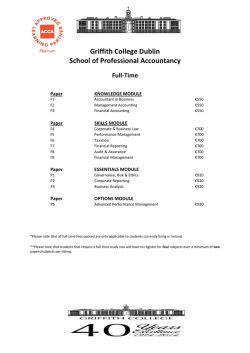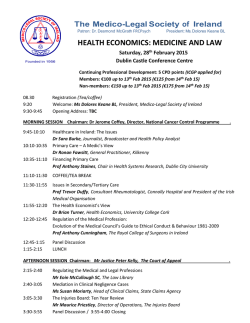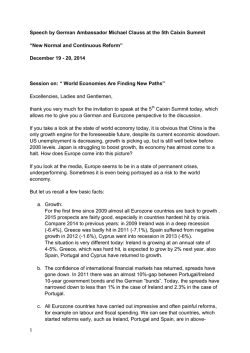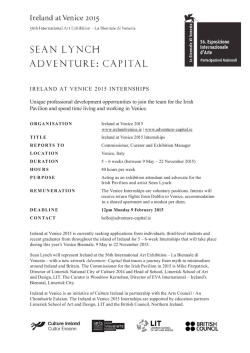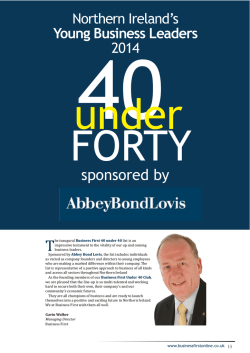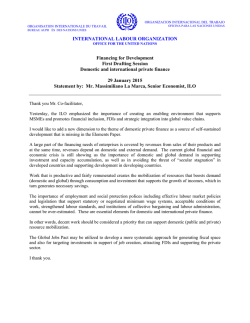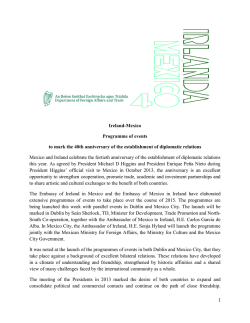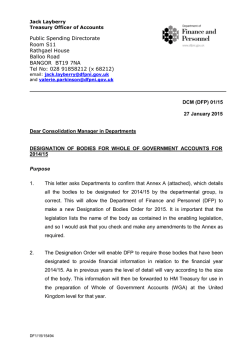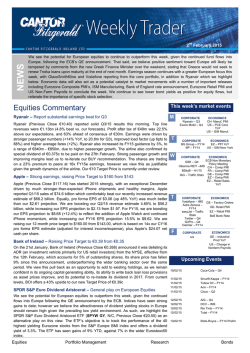
The Global Economy
The Global Economy Globalisation Concepts • A single interdependent global economy has emerged with different areas having different roles. • The global scale of the activities of multinational corporations (MNC’s) What is Globalisation? • Globalisation can be seen as the increased economic interdependence between countries. • Globalisation is defined by the U.N. as ‘The growing interdependence of the world’s people through shrinking space, shrinking time and shrinking borders’. • Globalisation refers to the economy of today’s world. It has economic, political, cultural and technological aspects that are closely interlinked. flow of information, communication, trade, borrowing/loans, aid, migration, investment and travel. • Interdependence is the way on which each region of the world depends on another for something. The South provides unprocessed minerals and agricultural materials. The North provides finished products that are then sold around the world. Top 20 most globalised countries (2006) Top 15 globalised economies (2010 finfacts.ie Ernst & Youngs Index) Increase in international trade is faster than the growth in the world economy Increased role of international organisations e.g. WTO, IMF that deal with international transactions Creation of international agreements leading to organisations such as the WTO and OPEC Economic Characteristics of Globalisation Reduction/ removal of tariffs; establishment of free trade areas Increase in international flow of capital Development of global financial systems Increase in certain types of economic practice e.g. outsourcing by MNCs Reduced Transportation costs, due to development of containerisation for ocean shipping. Greater international cultural exchange Spread of multiculturalism and more access to different cultures e.g. through the export of Hollywood and ‘Bollywood’ films Development of a global telecommunications infrastructure and greater international information flow e.g. via internet Greater international travel and tourism Cultural Characteristics of Globalisation Spread of local foods e.g. chinese, Italian food to other countries. Worldwide fads and pop culture e.g. Sudoku, Big Brother, Youtube Increasing usage of foreign phrases e.g. Adios Increased migration The demand by many for an international criminal court and international justice organisations Causes of Globalisation • Globalisation has occurred because of a number of developments around the world. 1. Advances in modern communications 2. Growth of multinational companies 3. Development of globally linked financial systems 4. Improved transport 5. Free Trade agreements 1. Advances in modern communications • Internet, e-mail, mobile telephones, satellite television etc. has made business and social communications between people easier regardless of distance. • Without rapid communications, MNCs could not operate efficiently in different countries. 2. Growth of MNCs • Globalisation has enabled the growth of corporations into very large international corporations e.g. Microsoft, Johnsons & Johnson • They invest large amounts of money (foreign direct investment FDI) to set up mining operations, factories and offices in different countries. • They purchase inputs, produce goods and services and sell them at global (world) levels. • Example: Design of a product may take place in the US, manufacture in the SE Asia, and transported to be sold in Europe 3. Development of globally linked financial systems • Money is the major product on the global market. • Technology enables the movement of approximately $1.3 trillion dollars every day around the world. • Stock exchanges control this movement of money around the world. ▫ Allows companies to operate in many different countries. ▫ Four major stock exchanges - NASDAQ (New York), NYSE (New York), TSE (Tokyo), London (LSE) • Global system is based on banking, borrowing and debt. ▫ Unfair advantage to MNCs over small- and medium-sized enterprises (SMEs). 4. Improved Transport • Bulk shipping, containerisation, air travel have all reduced the costs and time involved in moving large amounts of raw materials, goods and people over longer distances. 5. Free Trade Agreements • The removal or trade barriers and tariffs has enabled the growth of the multinationals. • Trade organisations such as the EU, NAFTA, Mercosur encourage free trade. • The World Trade Organisation (WTO) is the international body which deals with the rules of trade between countries. It promotes free trade and encourages the removal of trade barriers. Corporate Strategy in the Global Economy • Three factors influence the decisions of MNCs to move in or out of a particular location. ▫ Wage Costs ▫ Product life cycle ▫ Changes in the global economy Wage Costs • Significant expense to the company. • International division of labour has emerged in the global economy. ▫ Labour intensive companies e.g. sports shoe producers located in regions with low wage costs e.g. Taiwan, Vietnam. Wages are as little as 10% of those in more developed countries. Few labour laws to protect workers. ‘sweatshop’ production ▫ Pharmaceutical MNCs need educated workers etc. so they choose to locate in regions where they employ fewer but highly paid workers. Product life cycle • Produce Life Cycle Model – shows the relationship between production, consumption and trade over the ‘life’ of a product. • It shows how the location of production factories is moved from developed countries (core regions) to less developed countries (peripheral regions) as the product becomes better known and more people buy it. • The cycle can be as short as a few months or many decades. Product life cycle Product life cycle • Phase 1 - Introduction – ▫ The product is researched and developed. ▫ Access to scientists, technology and investment money is important. ▫ Production costs and sales price are high. ▫ Location is restricted to core urban areas. • Phase 2 – Growth – ▫ The product increases in sales. ▫ Increased demand leads to product improvements and the need to open more production plants. ▫ Skilled workers, good regional markets and infrastructure results in the new production plants being located away from the original manufacturers country to take advantage of transport costs and government incentives Product life cycle • Phase 3 - Maturity – ▫ ▫ ▫ ▫ Competitors enter the market. Price, and therefore the profits, decline. The market is saturated with the product (or cheaper copies). Less-skilled and lower-cost labour, cheaper land and good transport systems to access world markets forces the MNCs to relocate to peripheral regions within developed countries or to the Newly Industrialised Countries (NICs). • Phase 4 – Decline – ▫ The product has either gone out of fashion or been replaced by newer more innovative technology. ▫ Sales drop. ▫ The product may become obsolete and production may stop completely. ▫ If the product is stagnant, low labour costs, flexible workers, cheap land, government grants and access to world markets may encourage the MNC to locate in less developed countries. Changes in global economy • International events can influence a company to leave a region. ▫ Currency devaluations ▫ Terrorist attacks ▫ Political unrest ▫ Any change in the economic performance of Japan, the EU and America will affect MNC operations around the world. Impact of Globalisation Food – we now have access to a greater variety of foods from across the world. Choice has been improved and our diet has become more varied. We can buy food from anywhere in the world during any season. Irish supermarkets sell apples from New Zealand, often cheaper than those grown locally. This is not a free market at work, but the result of huge subsidies aimed at promoting global trade. MNC’s now have almost complete control of agricultural production and distribution – bananas, coffee etc. Small and medium sized farms close down even though they provide more jobs and take better care of the land. Impact of Globalisation • The South – One of the most common arguments for increased trade is that it will bring investment and wealth to the South. • However, this has not been the case. ▫ Every year, millions of people are attracted off the land by the promise of a job in the modern sector, only to find themselves in vast urban slums or a shanty towns, unable to meet even their most basic needs. ▫ They lose their sense of culture, identity and selfworth. Impact of Globalisation • Jobs – In the global economy jobs are becoming more temporary and insecure. • Wages are falling and working hours are increasing. • Workers in the South are becoming increasing dependent upon large foreign corporations for employment, eventually losing all choice as the local and national economies collapse. ▫ They can then be forced to accept lower wages and poorer working conditions. Impact of Globalisation • The environment – globalisation damages the environment. • More trade means more transport which produces more pollution. • Global warming as a result of climate change is being impacted by the increased demand for fossil fuels as economies expand. Impact of Globalisation • Democracy – All of the global economic institutions have increasing political power. • Power rests with international organisations such as the WTP, OECD, IMP, EU etc. ▫ All of these have multinational corporations lobbying for favourable decisions. ▫ ‘Free Trade’ can often be put forward as an argument against banning substances that are bad for health. Impact of Globalisation • Community – rural areas are being ignored and diverse cultures are being lost. • MNC’s can create a global consumer monoculture – ‘Coke’. • On the positive side, the expansion of the Internet and satellite television means greater and more timely access to world events and understanding of life in different areas / cultures. Impact of Globalisation • Anti-globalisation protests – the growing awareness of the negative impact of globalisation has resulted in protest meetings – especially whenever the major economic leaders are meeting. • They include labour unions, environmentalists, and some religious leaders who challenge globalisation. Impacts of Globalisation MNCs and the Global Economy • Multinational Companies (MNC’s) – are corporations that have production factories and service centres located in more than one country. • Foreign Direct Investment (FDI) – is the money invested by the MNC’s in foreign countries. With improved transportation and communication systems, they can coordinate their production and sales as part of a single global system. • MNC’s control increasing amounts of global trade, production and employment. They have a major influence on the economic development of countries. • 82,053 MNC’s globally with 807,803 subsidiary companies and account for 1/3 of the value of global exports. Foreign direct investment Location of MNCs • Access to raw materials • Access to cheap labour • Access to new and expanding markets • Flexibility of location MNC’s in Ireland • Ireland offers MNCs a politically stable, profitable, english-speaking base from which to trade with the world market. • About 1000 overseas compnaies have located in Ireland. • FDI is an important source of employment in Ireland. • 13 of the top 15 Pharmaceutical companies in the world have operations in Ireland. Why Ireland? • Competiveness is based on its educated, flexible labour force and quality communications infrastructures. • Ireland is seen as a good place to live. • Before the recession, the economy experienced huge growth. • Ireland continues to attract investment in areas such as communications e.g. Facebook, Sky, Google and financial and international services. World Competitiveness Report 2010 World Competitiveness Report 2010 World Competitiveness Report 2010 The Benefits for industry of locating in Ireland 1. Workforce ▫ Young workforce, with 40% under the age of 25 years. Migration from eastern Europe has added young skilled workers. 2. Research and development facilities ▫ The government has provided grants and encouraged the development and expansion of R&D facilities. The government is also encouraging an increase in the number of postgraduate and PhD graduates. The Benefits for industry of locating in Ireland 3. Tax Incentives ▫ ▫ ▫ The corporate tax rate in only 12.5%, which is extremely low by EU standards (Britain is 28%). Tax credits for expenditure on R&D are also available, which encourages the expansion of R&D facilities. The government has double taxation agreements with 65 countries, which allow MNC’s to pay tax in either the branch plant country or their home country – but not both. 4. Educated/ skilled workforce ▫ ▫ The education system in Ireland is one of the best in the world, according to the 2007 World Competitiveness Report. It produces 35,000 graduates every year. Since 1992, there has been a 35% increase in the number of students studying engineering and technology courses. World Competitiveness Report 2010 Technology: 34 of 139 •1 of 139 in terms of extent that FDI brings technology to a country. The Benefits for industry of locating in Ireland 5. Supply Chain Management ▫ This is the control of materials, information and finances as they move from the supplier to the manufacturer to the wholesaler to the retailer to the consumer. ▫ It involves coordinating and integrating these flows both within and among companies. ▫ It helps reduce costs involved in storage and delivery of goods. ▫ Ireland is developing expertise in SCM. Supply Chain Management • • • • • • • Sales forecasting Inbound & outbound transportation facilities Production planning Inventory management Warehousing facilities Customer service Sales order processing • Companies with successful SCM operations in Ireland include Apple. A Multinational Company based in Ireland It uses the global economy in the design, manufacture and marketing of its porducts. Company Profile • American MNC • Produces chemicals for medicines such as painkillers and cough mixtures as well as skin creams, baby products, contact lenses, medical devices etc. • Operates in more than 57 countries and is made up of over 250 companies worldwide. • In 2010 it sold more than over $61 billion worth of goods. • It employs over 114,000 people. • It is the 7th largest pharmaceutical companyin the world. Products Johnson &Johnson business segments Locations MNC’s locate in many different countries in order to lower their production costs and maximise their profits. Johnson & Johnson in Ireland • Employs over 2,000 people • Seven plants in Cork, Limerick, Dublin and Cashel. Plant: Manufactures: Vistakon Ireland, Limerick Contact lenses Janssen Pharmaceutical, Cork Pharmaceuticals DePuy Ireland, Cork Orthopaedics (treatment of skeletal disorders) Centocur Ireland, Cork Biopharma products (medical drugs produced using biotechnology) Cordis Corporation, Cashel Products linked with heart disease Alza Ireland, Cashel Transdermal medication J&J Medical, Dublin Medical equipment sales (joint replacements) J&J Consumers, Dublin Consumer product sales (baby care/ skin care) Johnson & Johnson, Ireland Why has Johnson&Johnson located in Ireland? • Supply of raw materials or other resources ▫ Investments/ improvements in water supply infrastructure in both Limerick and Cork Harbour. ▫ Water is important for pharmaceutical industries because it is used as an ingredient and for waster disposal in the production of liquid medicines. Why has Johnson&Johnson located in Ireland? • Labour Supply - MNCs locate in different countries so that they have access to either a low-cost or highlyskilled labour supply. Johnson & Johnson have a factory in Mexico to avail of low-cost, unskilled labour supply. Located in Ireland because Ireland offers highlyskilled labour force for the pharmaceutical production operations here. Young, educated workforce. 40% of the Irish workforce is under 25. In one J&J plant in Limerick over 500 people are employed (majority with third-level qualifications) Why has Johnson&Johnson located in Ireland? • Access to a market- MNCs locate in different countries in order to minimise transport costs involved in reaching their markets. ▫ 3 global economic zones in the world with wealthy populations – Japan, The EU and North America J&J located its European pharmaceutical operations in Ireland so that it can reach these 3 markets easily. E.g. Vistakon is a J&J company located in Limerick manufacturing contact lenses. The main market is the EU and Japan. Custom-free access to the EU market (product is made in the EU) Daily deliveries– Truck, Ferry, Truck, Plane ▫ Limerick Rosslare Port(Wexford) Pembroke Port (Wales) Heathrow Airport (London) Japan Why has Johnson&Johnson located in Ireland? • Government and tax policies – MNCs locate in countries with favourable tax systems ▫ Ireland has one of the lowest corporation tax rates in the world (12.5%). ▫ This is the tax rate companies pay on their profits. ▫ J&J decision to locate in Ireland was influenced by this tax rate. Rate in Japan is 41% Rate in UK is 26% Rate in France 33% Rate in US 35% Manufacture of contact lenses at Vistakon, Limerick. • HQ is in Florida • Opened in 1996 and employs over 650 in Limerick. ▫ Only Vistakon manufacturing site outside the US. • Designs, manufactures and markets a range of soft disposable contact lenses. • Largest producer of disposable contact lenses in the world. • Brand: Acuvue ▫ Leading product in the market. • Located in the National Technological Park, beside University of Limerick. • Technology at this plant is most advanced in the world for contact lense production. Growth of the company in Limerick • Limerick was chosen because: ▫ Ireland offered an English-speaking, highly skilled labour force. ▫ Government policy provided the technical support (site provision, planning and construction) to enable Vistakon to begin quickly. ▫ Johnson&Johnson had already established a successful company in Cork and were familiar with Ireland as a business location. Vistakon • Today the facility has 30 production lines to manufacture daily, forthnightly, monthly and colour lenses that are shipped worldwide. • In 2006 the company invested €100 million in its Limerick operations. ▫ New technology installed ▫ Ability to manufacture more complex next generation products ▫ 2010/2011 investment plan: The most recent development plans for Vistakon in Limerick include the start up of our Contact Lens Care facility. This represents a multi million euro investment and the end product will be an ACUVUE Contact Lens Solution to partner lens products. Vistakon have an aggressive growth strategy to make the most of the global contact lens market’s huge potential. Raw materials and transport • Gel-like substance used for the lense is imported fromNorth America. • Water and saline solution are provided locally. • Packaging is made by Boxmore in Limerick. • Electricity is provided by the ESB. ▫ Second largest power user in Munster. ▫ Has cmmitted to the development of sustainable energy. Electricity is provided by wind power suppliers. Production • Lenses are produced in a clean-room environment. • Production is fully automated. • Hygiene checks throughout. Waste management • 90% of waste at the plant is recyclable material and disposed of locally. • 10% is hazardous and sent from Ireland to the EU for incineration. Market • Sold around the world but Japan is main market.
© Copyright 2026
